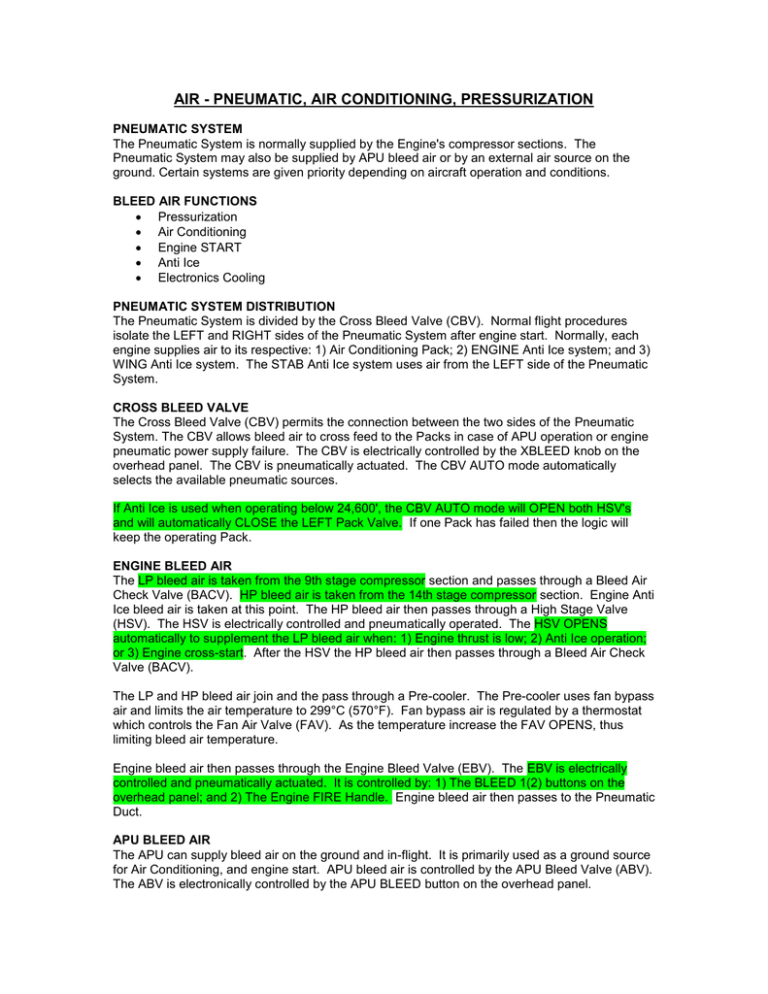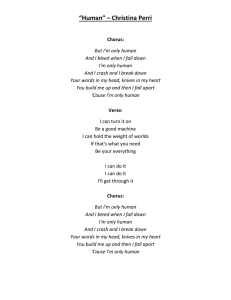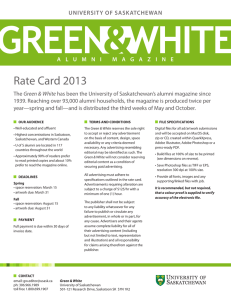air - pneumatic, air conditioning, pressurization system
advertisement

AIR - PNEUMATIC, AIR CONDITIONING, PRESSURIZATION PNEUMATIC SYSTEM The Pneumatic System is normally supplied by the Engine's compressor sections. The Pneumatic System may also be supplied by APU bleed air or by an external air source on the ground. Certain systems are given priority depending on aircraft operation and conditions. BLEED AIR FUNCTIONS Pressurization Air Conditioning Engine START Anti Ice Electronics Cooling PNEUMATIC SYSTEM DISTRIBUTION The Pneumatic System is divided by the Cross Bleed Valve (CBV). Normal flight procedures isolate the LEFT and RIGHT sides of the Pneumatic System after engine start. Normally, each engine supplies air to its respective: 1) Air Conditioning Pack; 2) ENGINE Anti Ice system; and 3) WING Anti Ice system. The STAB Anti Ice system uses air from the LEFT side of the Pneumatic System. CROSS BLEED VALVE The Cross Bleed Valve (CBV) permits the connection between the two sides of the Pneumatic System. The CBV allows bleed air to cross feed to the Packs in case of APU operation or engine pneumatic power supply failure. The CBV is electrically controlled by the XBLEED knob on the overhead panel. The CBV is pneumatically actuated. The CBV AUTO mode automatically selects the available pneumatic sources. If Anti Ice is used when operating below 24,600', the CBV AUTO mode will OPEN both HSV's and will automatically CLOSE the LEFT Pack Valve. If one Pack has failed then the logic will keep the operating Pack. ENGINE BLEED AIR The LP bleed air is taken from the 9th stage compressor section and passes through a Bleed Air Check Valve (BACV). HP bleed air is taken from the 14th stage compressor section. Engine Anti Ice bleed air is taken at this point. The HP bleed air then passes through a High Stage Valve (HSV). The HSV is electrically controlled and pneumatically operated. The HSV OPENS automatically to supplement the LP bleed air when: 1) Engine thrust is low; 2) Anti Ice operation; or 3) Engine cross-start. After the HSV the HP bleed air then passes through a Bleed Air Check Valve (BACV). The LP and HP bleed air join and the pass through a Pre-cooler. The Pre-cooler uses fan bypass air and limits the air temperature to 299°C (570°F). Fan bypass air is regulated by a thermostat which controls the Fan Air Valve (FAV). As the temperature increase the FAV OPENS, thus limiting bleed air temperature. Engine bleed air then passes through the Engine Bleed Valve (EBV). The EBV is electrically controlled and pneumatically actuated. It is controlled by: 1) The BLEED 1(2) buttons on the overhead panel; and 2) The Engine FIRE Handle. Engine bleed air then passes to the Pneumatic Duct. APU BLEED AIR The APU can supply bleed air on the ground and in-flight. It is primarily used as a ground source for Air Conditioning, and engine start. APU bleed air is controlled by the APU Bleed Valve (ABV). The ABV is electronically controlled by the APU BLEED button on the overhead panel. The Pneumatic System gives priority to the Engine Bleed Air over the APU Bleed Air. The ABV is CLOSED if the LEFT EBV is OPEN, or both the RIGHT EBV and CBV are OPEN. There is an APU Check Valve downstream of the ABV that prevents reverse air flow from an Engine. EXTERNAL AIR START For Engine start there is a high pressure ground connection with a check valve installed on the RIGHT side of the Pneumatic System. It is used only for Engine start. BLEED AIR LEAK / OVERHEAT Leak detection is provided by thermal switches installed along the lines. When one of these switches is activated EICAS displays a warning message. Leaks may be detected by a differential pressure switch at the Pre-cooler, and/or three thermal detection switches at the Rear Electronic Compartment. A bleed air leak detection will CLOSE the respective EBV and the CBV. Temperature sensors upstream and downstream of the Precooler monitor the bleed air temperature. The downstream air temperature is displayed on the ECS page of the MFD. ENGINE BLEED VALVE (EBV) and PRESSURE REGULATING SHUT OFF VALVE (PRSOV) Older aircraft have EBVs that do not have any bleed pressure control. As a result, high pressures may be applied to the Pneumatic Systems. PRSOVs have been installed to prolong component lifetimes. EBV Aircraft: The CBV is automatically commanded to OPEN during icing conditions. It is intended to balance the airflow distribution to guarantee that bleed air is equally extracted from each engine, and is evenly distributed between the LEFT and RIGHT Wings. PRSOV Aircraft: The PRSOVs automatically control pressure on each side of the bleed system, thus the LEFT and RIGHT PRSOVs may deliver air with slightly different pressures. The PRSOV will remain closed until bleed air is required, if the BLEED 1(2) button is on. For example, during takeoffs without Pack or Anti Ice demands, the PRSOVs will automatically close. The BLD 1(2) VLV CLSD advisory message will be displayed in flight, but it is inhibited on the ground. This message may persist for a few seconds after encountering icing conditions when bleed air is required and the PRSOVs open. The PRSOVs may also be opened by resetting the Packs, such as during the climb flow, thereby extinguishing the advisory message. In PRSOV equipped aircraft The CBV's function was changed so that it remains CLOSED even in icing conditions. Embraer's tests demonstrated that the Pneumatic System can supply all the thermal Anti Ice systems and other pneumatic systems with the CBV in the CLOSED position. The Engines adequately share the airflow. There is no need to OPEN the CBV in icing conditions. There is no need to exit or avoid icing conditions if the CBV fails CLOSED. In PRSOV equipped aircraft, the CBV is still selected OPEN for cross engine starts. Single Engine / Single Bleed operation in icing conditions continues to require OPENING the CBV valve. AIR CONDITIONING SYSTEM There are two high capacity Air Cycle Machines (ACM) or (Pack) supplied by the Pneumatic System. Each Pack is independently controlled and protected and can cross connect in various modes of operation. Cockpit and Cabin Air Temperature are independently controlled in either automatic or manual modes. The Attendant Panel can be given control over the Cabin Air Temperature. ENVIRONMENTAL CONTROL UNIT (PACK) Each Pack is comprised of: Dual Heat Exchanger Air Cycle Machine o Compressor o Turbine o Fan Condenser Water Separator Controls Protections Bleed Air is modulated and regulated by the Pack Valve (Pressure Regulating and Shut Off Valve, or PRSOV). The Pack Valve maintains the downstream pressure at a predetermined level. After passing the Pack Valve the air is cooled in the primary heat exchanger and passes through the compressor, thus causing a pressure increase. The air then goes to the secondary heat exchanger where it is cooled again. After leaving the secondary heat exchanger, the highpressure cooled air passes through a condenser and a water separator for condensed water removal. Spray nozzles use the separated water to improve the heat exchanger efficiency. The main airstream is ducted to the turbine and expanded to provide power for the compressor and cooling fan. This energy removal produces very low turbine discharge temperatures, achieving adequate low temperatures in the process. The cold exit air is mixed with warm air supplied by the recirculation fan and/or with the hot bypass air immediately upon leaving the turbine. A check valve is provided in the recirculation duct to prevent reverse flow if the recirculation fan is inoperative. The ECU outlet air temperature is controlled through the dual temperature control valve. One valve adds hot bleed air to the turbine discharge while the other valve restricts the compressor inlet flow. In-flight the Packs are cooled by their respective ACM Fans and external ram air via the NACA Inlets. On the ground, the Packs are cooled only by the ACM Fans. The Packs will automatically shut off for over temperature and over pressurization malfunctions. NOTE: The Pneumatic System CLOSEs the LEFT Pack Valve whenever the Anti Ice System is ON below 24,600'. PACK CONTROL MODES AUTOMATIC: The AUTO mode operates with the control button PRESSED IN. The cockpit and cabin temperatures are controlled by the Digital Temperature Controllers. Sensors in the ducts, cabin and cockpit give feedback to the Controller so that it will maintain the desired temperature. AUTO mode failure is indicated when the stabilized temperature is NOT maintained within limits (18°C - 29°C). MANUAL: The MANUAL mode operates with the control Switch PULLED OUT. The cockpit and cabin temperatures are controlled by the Temperature Control Module (TCM). The TCM receives information from the Temperature Mode Selector Knob and Duct Temperature Sensor. NOTE: Only use the MANUAL mode when there is a failure in the AUTO mode. RAM AIR VENTILATION If the Pack air supply is shut off then the Emergency Ventilation System using Ram Air is the alternative. The Ram Air Valves OPEN automatically and the same air that cools the dual Heat Exchangers is distributed. Ram Air is also available for smoke evacuation and also to ventilate the aircraft when it is depressurized. DISTRIBUTION Cockpit air is primarily provided by the LEFT Pack. There is a single Distribution Line for both cooling and heating. Air is tapped off for CRT Display ventilation and there is an independent electrically driven Shut Off Valve on each side. Each SOV is controlled by a Thermal Switch allowing cold air to circulate at 41°C (105°F). Cabin air is primarily provided by the RIGHT Pack and partially by the LEFT Pack. There is a cross duct connection. There are 3 distribution lines. One line supplies the lower ducts on both sides at foot level. Another line supplies the upper ducts on both sides. The third line supplies the Gasper system and the upper ducts. The Gasper air subsystem provides air to each Passenger Service Unit (PSU), the rear electronic compartment, oxygen cylinder compartment and the relay box. The Gasper system is driven by a Gasper Fan and distributed through one branch of the general distribution system. The Gasper system also ventilates the Attendant Station, and Lavatory. Re-circulating air, driven by two electric fans, is mixed with fresh air in order to improve passenger and crewmembers' comfort. The fans are controlled by the RECIRC button on the overhead panel. They are turned OFF when smoke is present in the cabin, and on hot or cold soaked aircraft while on the ground. A Temperature Switch that commands the Recirculation Fans to increase the air flow when the temperature is below 24°C (75°F). The Ground Cart connects at the RIGHT Duct and has a check valve. This conditioned air is directly distributed to the Flight Deck and Cabin. CABIN PRESSURE CONTROL SYSTEM (CPCS) The CPCS regulates the Cabin Pressure by controlling the Cabin Exhaust Air supplied by the PACK's. There are 2 Subsystems: Digital Electro-Pneumatic AUTO Mode Pneumatic Subsystem MANUAL Mode. Together the Subsystems have: Digital Controller Manual Controller Electro-Pneumatic Outflow Valves (E-POV) Pneumatic Outflow Valve (POV) Air Filter 2 Pressure Regulator Valves Ejector Pump 2 Static Ports Cabin Pressure Acquisition Modulate (CPAM). CPCS AUTOMATIC MODE The AUTO Mode is commanded by the Digital Controller. It is the default mode when the aircraft first receives electrical power. The landing altitude must be entered before takeoff. The Manual Controller must be set to DN position. According to the Landing Altitude the Digital Controller schedules a Cabin Altitude while imposing a minimum cabin altitude rate of change. The Digital Controller computes a Theoretical Cabin Altitude as a function of the aircraft operating altitude. It is calculated to provide a Maximum Cabin Differential pressure of 7.8 PSI (8000’) that is reached at the lowest possible aircraft altitude while computing a minimum cabin altitude rate of change and a maximum aircraft rate of climb. The Digital Controller considers the following inputs: Measured Caning Pressure ADC Inputs Air / Ground Sensing Thrust Lever position The Digital Controller signals the E-POV to OPEN or CLOSE to regulate cabin pressure. The EPOV functions by balancing electric solenoid force against vacuum generated by the Ejector Pump using regulated Bleed Air from the Pneumatic System. When in the AUTO mode the POV is slaved to the E-POV and both operate simultaneously. Both E-POV and Pneumatic Outflow Valves receive static pressure signals from the Static Ports to provide protections to prevent structural damage due to improper CPCS operation. Positive Cabin Differential Pressure Relief: Negative Cabin Differential Pressure Relief: Cabin Altitude Limitation (AUTO mode): above 8.1 PSI, below -0.3 PSI, 14,500 ± 500' PSI. The normal maximum cabin altitude rates of climb and descent are +650 FPM to -450 FPM. Descent rates may be increased to a value between -450 FPM and -1300 FPM. The cabin is scheduled to be slightly pressurized for takeoff and landing. When taking off with no Air Conditioning the Outflow Valves are CLOSED. After landing the Cabin will climb at 650 FPM until the Outflow Valves are full OPEN. Any remaining pressure is lost when the Air Conditioning is turned OFF or a Door is OPENED. EICAS displays a message if the AUTO mode fails. CPCS MANUAL MODE The MAN mode is commanded by the Manual Controller. Only the POV is commanded. The EPOV is maintained CLOSED. MAN mode is accomplished by: 1. Rotate the Manual Controller Knob (Pedestal) to the 1 o'clock position. 2. Then select the MAN mode button. 3. Then rotate the Manual Controller Knob as necessary to the desired Cabin Rate of Change. The crew is responsible for monitoring the Cabin Differential Pressure within acceptable limits. EMERGENCY Rapid depressurization can be accomplished in either AUTO or MAN modes. In the AUTO mode use the DUMP button. In the MAN mode turn the Manual Controller to the full UP position. FORWARD ELECTRONIC BAY COOLING Most of the electronic equipment is in the nose and there is an automatic system for cooling it. The System consists of: 2 NACA Inlets, 2 Shutoff Valves (SOV), 2 Recirculation Fans, 2 Exhaust Fans, 2 Check Valves, 4 Control Thermostats, 2 Overtemperature Thermostats. The NACA Inlets have water separators and drains to prevent ingestion into the Bay. With power on the aircraft the Inverter Modules are powered supplying the Fans with power. The Recirculation Fans operate continuously when energized. The Check valves prevent water from entering the compartment through the Exhaust Fans. If the Bay temperature exceeds 24°C (75°F) then the Control Thermostats OPEN the SOV's and Exhaust Fans RUN. When the temperature drops below 19°C (66°F) then the SOV's CLOSE and the Exhaust Fans STOP. If the temperature limit is reached the two over temperature thermostats activate an EICAS message: ELEKBAY OVTEMP. AFT ELECTRONIC BAY COOLING The electronic equipment in the Aft Electronic Bay is cooled by conditioned air discharged from the cabin when in-flight or when the doors are CLOSED. The discharged air flows from under the floor through the Aft Bay to the Outflow Valves. On the ground when the aircraft is depressurized an outlet blows air from the Gasper Fan to the Aft Electronic Bay. BAGGAGE COMPARTMENT VENTILATION Airplanes equipped with “class-C” baggage compartment have a Baggage Ventilation System installed. Although no dedicated temperature control is available (the “class-C” baggage compartment is heated by the passenger cabin air flowing into it), the Baggage Ventilation System provides an adequate environment for carrying live animals in the compartment. The Baggage Ventilation System is composed of two ambient check valves and a baggage compartment fan. Whenever the recirculation fan is off, the forward check valve prevents reverse flow into the passenger cabin and the two check valves prevent smoke or fire extinguishing agent penetration into the passenger cabin or into the rear electronic compartment. BLD 1 (2) LEAK Duct LEAK in the associated Bleed Line. Temperature exceeds 91°C (195°F). Switch deactivates at 79°C (175°F). BLD APU LEAK Duct LEAK in the associated Bleed Line. Temperature exceeds 91°C (195°F). Switch deactivates at 79°C (175°F). BLD 1 (2) OVTEMP Associated Precooler downstream temperature > 305°C ((581°F). APU BLD VLV FAIL Disagreement between actual and commanded position. BLD 1 (2) TEMP: Either: 1. Abnormal Low Bleed Air Temperature 2. Asymmetrical Bleed Air temperature 3. Precooler Outlet Temperature Sensor Failure BLD 1 (2) VLV FAIL Disagreement between actual and commanded position. CROSS BLD FAIL Disagreement between actual and commanded position. CROSS BLD SW OFF Crossbleed Switch selected CLOSED when at least one Engine is running after Brake release. HS VLV 1 (2) FAIL Disagreement between actual and commanded position. PACK 1 (2) OVLD Associated ECU: 1. Compressor Temperature > 243°C (470°F), 2. ECU Inlet Pressure > 55 PSI. PACK 1 (2) OVHT Associated ECU Outlet Temperature > 93°C (200°F). PACK 1 (2) VLV FAIL Disagreement between actual and commanded position. RAM AIR VLV FAIL Disagreement between actual and commanded position. PRESN AUTO FAIL Automatic Mode has failed. ELEKBAY OVTEMP: Temperature in the Forward Electronic Bay exceeds 71°C (160°F) Maximum. BLD 1 (2) VLV CLSD Associated Engine Bleed Valve position. This message is INHIBITED: 1. On the ground or 2. During the respective Engine START. CROSS BLD OPEN: Cross Bleed Valve -- OPEN PACK 1 VLV CLSD LEFT Pack Valve CLOSED with a) NO Icing condition, or b) above 24,600'. PACK 2 VLV CLSD RIGHT Pack Valve CLOSED. CABIN Aural Warning when the Cabin Altitude exceeds 9900' ± 100'. Cabin Altitude Indication is RED.




